
VOL. II NO. 8 REG. NO. L5015 DELHI, THURSDAY NOVEMBER 5, 1943.
|
14TH AIR FORCE HQS. - In the past week, the 14th U.S. Air Force blasted Japanese shipping, rail yards, installations, troops and barracks in devastating raids over China and in French Indo-China. A total of 23 Jap aircraft were destroyed in these missions.
On Oct. 26, Liberators attacked railroad marshalling yards at Haipson and the village of Tengchung, and Mitchells struck at enemy shipping off Hainan Island. Ten enemy planes were destroyed on the ground and one when it was taking off. A transport and two tankers were sunk. Dock installations were also attacked.
LUNG LING HIT
The next day, Lung Ling, Japanese-held city on the Burma Road, was blasted, starting many fires. On leaving, the planes met eight Jap fighters. In a 50-minute battle, the gunners shot down three confirmed and one probable. Later the 14th Air Force planes were attacked by eight more Jap planes. Five Zeros were downed and one was probably destroyed. The rest were damaged and driven off.
On Oct. 28, B-25's on a shipping sweep off Kwangehowan Peninsula, attacked two 150-foot freighters, sinking one and probably the other. Other B-25's made a surprise attack on Japanese barracks near Fort Bayard, inflicting many casualties. One Jap fighter was destroyed on the ground. In central China, fighters made a low-level attack on Yechow airdrome and warehouses. A factory and two buildings at Kiemli were left burning. On the Salween Front, Liberators dropped four tons of bombs on the Japanese-occupied town of Mangshih. Eight Japanese aircraft bombed an Allied airdrome in southwest China, inflicting minor damage.
AID CHINESE
Two days later, B-25's, in support of the Chinese troops fighting in central China, bombed the motor park and barracks at Shayang. Twin-engine P-38's dive-bombed shipping and the docks at Kiukiang on the Yangtze River. Two Zeros were shot down.
On Nov. 1, Mitchell bombers again in the support of Chinese troops operating in the central Yangtze River area, dropped nine tons of bombs on warehouses and railroad yards at Yochow. Large fuel oil fires were started. 14th Air Force planes encountered heavy anti-aircraft fire, but all returned safely.
|
Maj. Gen. George E. Stratemeyer, high poobah of the Air Forces, was initiated last week into what is probably the most select organization of the theater.
Accompanied by Col. Frank Merrill, now with the SEAC staff, Col. Frank Milani, Theater Adjutant and John Davies, ubiquitous Second Secretary of the Embassy on Lt. Gen. Joseph W. Stilwell's staff, the general became a member of The Cardinals.
The history of The Cardinals seems a bit vague and has nothing to do with the National League. Col. Roy W. Bowlin, Theater Ordnance Officer, is the Chief Cardinal and presides at ceremonies in long-handled red underwear and a fez. Bowlin has long since forsaken the "perfect 36" and it's quite a spectacle.
The order is one dedicated to the spirit of good cheer and manly sport and has a membership of about 20 in CBI. The crux of the entire ceremony is an ability to mimic. The chief cardinal goes through a routine surrounding a glass of spirits diluted 50% with water. The neophyte must follow exactly. If the slightest error is made the victim must down the hatch with his drink and do it all over again.
The general made it after eight tries and needed a little coaching. Davies, who recently lost a front tooth, thereby becoming a member of the Huckleberry Finn Club, made it after four; Merrill came through in four and Milani cut the mustard with a magnificent three on a par five hole. Davies might have made it in less but he had a head start.
LOOEY RECOVERS PURLOINED JEEP FROM GEN. ARMS
14TH AIR FORCE HEADQUARTERS, CHINA - Will someone in the know please communicate to Lt. Davis E. Sagi, here, what Army regulation covers the situation when a provost marshal lieutenant discovers a brigadier general riding around in a stolen jeep.
That's what happened here recently, and Sagi guesses he handled the situation correctly, because he's still out of his own jail and still has his commission.
Not long ago, one of the jeeps at this headquarters was reported stolen, so Sagi put out a circular and telephoned the Chief of Police of a nearby Chinese city for aid in recovering the purloined property.
The very next afternoon, Sagi, looked out the window of his provost marshal's office and lo! someone was driving the stolen jeep up the road. With a view to bringing the culprit to justice, the lieutenant dashed out just in time to see the driver alight.
It was Brig. Gen. Thomas S. Arms.
Sagi gulped a couple of times, but duty is duty. So he accosted the general in best provost marshal style, to find out what went on.
Arms had an alibi. According to his story, the "stolen" jeep had been parked next to one which one of his officers was using, and the driver had taken the wrong one by mistake, leaving this one for the general.
Case dismissed.
 Eastern Asia's "Casa Blanca" took place recently when Lord Louis Mountbatten, new supreme commander of the Southeast Asia Command, journeyed to China for his first meeting with Generalissimo Chiang Kai-shek. Above you see a distinguished group of those present, including, left to right, Gen. Ho Ying Chin, Chinese Minister of War, Lt. Gen. Brehon Somervell, commanding general, Service of Supply, U.S.A., Generalissimo Chiang Kai-shek, Mountbatten, Madame Chiang Kai-shek and our own Lt. Gen. Joseph (Uncle Joe) Stilwell.
Eastern Asia's "Casa Blanca" took place recently when Lord Louis Mountbatten, new supreme commander of the Southeast Asia Command, journeyed to China for his first meeting with Generalissimo Chiang Kai-shek. Above you see a distinguished group of those present, including, left to right, Gen. Ho Ying Chin, Chinese Minister of War, Lt. Gen. Brehon Somervell, commanding general, Service of Supply, U.S.A., Generalissimo Chiang Kai-shek, Mountbatten, Madame Chiang Kai-shek and our own Lt. Gen. Joseph (Uncle Joe) Stilwell.
|
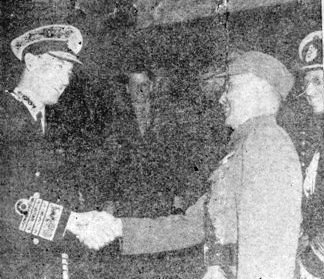
|
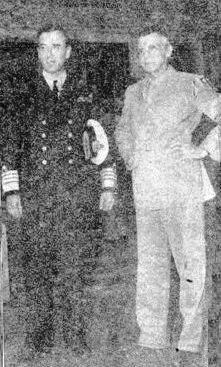
|
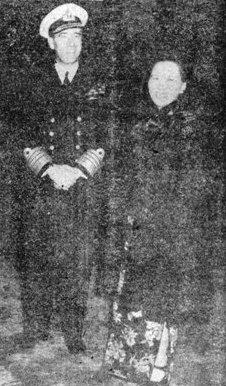
|
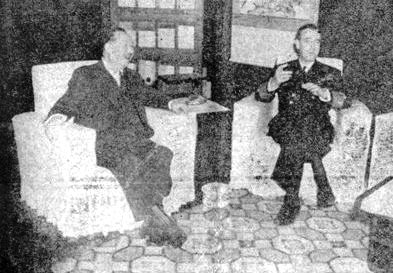
|

|
LEGION OF MERIT AWARDED TO TWO
The high award of the Legion of Merit has been given to Maj. Winfred J. Smith, and posthumously to Maj. Roy C. Hoffman, it was announced by Rear Echelon Headquarters this week.
Hoffman, former AVG officer, was killed in action in August. He received the Legion of Merit for his "invaluable service in helping to solve acute technical problems."
Smith received his award for military intelligence work on many raids with the Advance Echelon of the 14th Air Force. He was cited for exceptional initiative and organizational ability.
Two other awards were also announced by the Rear Echelon Headquarters. The Air Medal was given to Capt. Jack W. Slaton and Lt. E. Champion for meritorious aerial achievements.
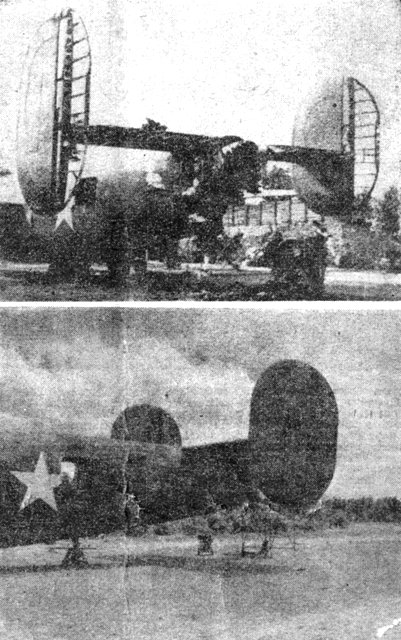
|
Within a few days, a P-40, which was considered doomed to the scrap heap, will return to combat duty.
Thank the Engineering Department of this Air Service Center, under the command of Maj. Hugh Tate, for saving the lives of these two vitally-needed planes just as surely as a gifted doctor rescues a patient from a death bed.
Tate, veteran of 26 years Army service, and his assistant, Capt. Horatio Whitehead, refer to their __th Service Group unit as an "airplane hospital." It's exactly that, administering to the injuries and ailments of every type of aircraft from a trainer plane to a four-engined bomber. The B-24 returned to duty and the P-40, almost ready to resume action, are only two instances of numerous aircraft patients which have been pronounced "cured."
GREAT RECORD
Snuggled up behind bomber bases in Eastern India, the __th Air Service Group is doing a miraculous job. Army regulations call only for third echelon repairs, but with this hard-working unit it's not a question of what echelon repairs are needed but a question of "what we can do." The number of planes sent here to be repaired is, of course, clouded in military secrecy, but it may be revealed that 90 percent have been returned to combat duty and only 10 percent to a service depot, which is responsible for fourth echelon repair. This is an enviable accomplishment.
The B-24 whose tail was consumed by fire met with its accident coincidentally with a pileup of another Liberator, 120 miles distant, during which its nose section was demolished. A crew from the Service Center transported the serviceable tail of the one plane to the field where the other had lost its tail and started to work immediately on the major welding task. According to Tate, the Liberator's return to combat duty - eight missions at last report - is the first recorded in Air Corps annals after such an operation. Sgt. Robert Davis of this base reports of having recently met one of the bomber's crew members at a rest camp and being informed the ship is "faster than before."
Members of the __th who participated in this job were M/Sgt. Robert F. Dilley, T/Sgt. Charles K. Wilson, S/Sgts. Oscar G. Haight, George L. Corner, Leslie F. Coad, Alvin E. Hahe and Roy C. Brannon, Cpl. William L. Harbum, Pfc. Harvey C. Petermier and Pvt. Gilmore F. Lunsford.
If a plane can be flown here for repairs, that is so much gravy. Often, however, repair crews must be transported into the field and patch up the ship enough to enable it to be brought here. In some instances, the work must be done in the field under trying circumstances.
INGENIOUS JOES
American mechanical ingenuity plays a large part in the remarkable record of the __th. When parts are unobtainable or when waiting for their arrival from the States would ground a needed ship for several months, these are improvised or rescued from the salvage heap or old parts are repaired. This calls for the expert, carefully-considered judgment, for a plane crew's life hangs in the balance. The answer to the __th's success and ability is the confidence of the 10th Air Force in its work.
|
After the P-40 clipped a tree and considerably scrambled itself, an inspection showed that 126 unobtainable parts were required for the repair job. Some were rescued from the scrap heap. Others were improvised. The rest were repaired from damaged parts of the P-40. The ship has been tested in the air twice by Maj. Dave Pace, but not passed 100 percent. T/Sgt. John T. Duke and Sgt. Dennis M. Cochrane, Pvt. Charles F. Mason and Pvt. Kenneth Lavigne promise it'll strut its stuff perfectly in its next test soon.
Tate is proud of his organization. Its spirit is exemplified in a motto it recently presented him: "If you want it immediately, we'll accomplish the impossible; if you give us a little time, we'll accomplish a miracle." They HAVE accomplished miracles since their arrival at an East India port Nov. 30, 1942, and the setting up of the center Jan. 19. Only 15 percent of the unit has been transferred since arriving in India as the first such organization to be shipped in its entirety to an overseas base. It's a big, happy family, considering the paucity of entertainment facilities and the over-generosity of monsoon rains.
Among the various departments, all manned by skilled personnel, are: Fuel tank salvage and reclamation, instrument, sheet metal, electrical, machine shop, welding, hydraulic, supercharge, carpenter, prop, heavy motor, drafting, engine change and paint, dope and fuselage.
A large percentage of the ranking non-coms have six years or more of Army service as a background. They've advanced many of the ideas for improvisation through which repair work has been facilitated. For instance, the __th was told there were no cannon plugs available for generators. So someone devised a cannon plug made out of water buffalo horn, which is superior to the original, constructed of hard rubber. Someone else improvised a hydraulic testing system. Another member of the unit invented a polishing wheel in the stead of an unobtainable sand blaster. These are only a few examples.
 We have four columns full of legs and things on the front page, but just to make doubly sure that the
Roundup's cheesecake fans have nothing to complain about this week, we're giving you a dividend in
the form of shapely Janis Paige.
We have four columns full of legs and things on the front page, but just to make doubly sure that the
Roundup's cheesecake fans have nothing to complain about this week, we're giving you a dividend in
the form of shapely Janis Paige.
|
|
A.P.O. 465 (Calcutta) - A morals committee, keeping watch and ward over the virtue of young girls, is something you'd hardly expect to find at an advance bomber base. But there not only is one here, composed of American officers and G.I.'s, but it also really means business. In fact, if at any time of the day or night you hear the loud roar of forty-fives fired in anger, it probably is the morals committee at work in grim earnest.
It's happened since Susie, a rather attractive bit of canine femininity, was acquired by the group as mascot. Susie is a beautiful, healthy-looking bitch, as Indian dogs go, and the idea is to keep her from misalliances with lower-caste dogs of the neighboring village, least an almost pure breed be lost forever.
The days passed peacefully for a while after Susie showed up as a stray and was adopted by a shy but thoroughly efficient aerial gunner. But then the gunner was transferred and caring for Susie's welfare fell to the lot of another member of the squadron, who was rather lax in his habits.
The inevitable happened. One day, to the dismay of onlookers, Susie was caught in what the courts
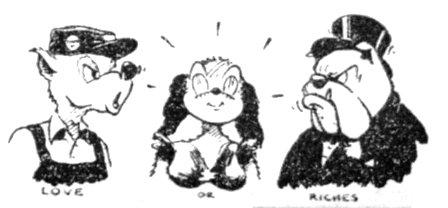 call "flagrante delicto" with just about the worst mutt in the village. The
alarm was immediately sounded and
everyone rushed for buckets of water to route the sinners. But the harm had been done. Now the squadron is waiting
with anxious hearts to learn whether or not Susie will have to pay the price for her slip from virtue.
call "flagrante delicto" with just about the worst mutt in the village. The
alarm was immediately sounded and
everyone rushed for buckets of water to route the sinners. But the harm had been done. Now the squadron is waiting
with anxious hearts to learn whether or not Susie will have to pay the price for her slip from virtue.
But it won't happen again. Susie is now almost always surrounded by grim, saddened men who take pot shots a stray dogs with a prayer in their hearts for Susie.
As the men see it, it's the old question of whether a girl, driven by the pangs of love, should marry without the consent of her parents, or marry for social prestige alone. It has become quite a bone of verbal contention here, with decided opinions on both sides, and members of the bomber group would like to get helpful expressions of opinion from other sectors.
"It's a damned lie!"
That's what they may say, the skeptics, when they hear the members of the "Ringer Squadron" boast of the number of trips old "59" has made over enemy territory in Burma.
Those who maintain the B-25 hasn't been built which can fly 100 missions are hereby informed that old "59" reached the century mark the other day and has roared into the sky to deal death and destruction to the Jap several times since.
On its 100th mission - an attack upon Meza Bridge - "59" was piloted by Lt. Robert E. Dales, slim, curly-haired youngster from Chency, Wash., making his 49th mission over Burma. For Lt. Raymond C. Curry, Jr., bombardier, it was the 50th time he had guided bombs to an enemy target. For navigator Lt. Gene E. Lefebyre and S/Sgts. J. H. Miller and C. T. Jenkins, it was old stuff too. But for the co-pilot, Lt. J. N. Pryor, it was his first combat mission as a member of the "Ringer Squadron."
"She still runs like a top," lauded Dales after the B-25 returned, adding that Pryor couldn't have had better company than "59" in his baptism.
The history-making B-25 has had more close shaves than a G.I. has gripes; she's seen practically every target on which the 10th Air Force has put its finger in Burma; she has witnessed the death of the only combat man lost by the squadron; she has struggled through weather in which you wouldn't see your worst enemy (unless he's a Jap); she knows a thousand exciting, grim and humorous stories of the men who have tended her on the ground and kept her flying and of the men
|
Lt. Col. Blair M. Sorenson, first C.O. of the "Ringers," now with group headquarters, first flew "59." He and Capt. Robert Simmons saw her through clashes with the enemy, blankets of ack-ack and the filthiest weather this side of Hell. She was always Sorenson's favorite ship.
Old "59" is not fickle. She flies for all the boys. Many of the pilots who flew her - dashing young Texans like Capts. John Tyson and Frank Redman - have returned to the States. So, too, have navigators, bombardiers and engineers and radio gunners.
Many of the enlisted men who have labored over "59" and swore at every bullet hole they had to patch were buck privates when the old war horse first came into action, but few of them still are. Phil Bach is a tech sergeant. Cecil Noe is line chief and a master sergeant. So is Gordon Spurlock. Karl Hammett, her present crew chief, is a tech, helped by Cpls. Melville Farren and Fernand Arel. Cpl. Norman Lloyd has looked after her guns.
BAND PLAYS BY FLASHLIGHT TO ENTERTAIN EAGER G.I.’s
CENTRAL INDIA DEPOT - G.I.'s at this Air Depot in Central India greeted the musical offerings of the famous Indian Hyderabad band with unreserved enthusiasm at their second appearance here last Friday night. Playing by flashlight because of a local power failure, the band in fine tradition presented a program of popular music that brought a deep throated response from some 2,000 men present to hear the program and to see the motion picture which followed.
Hyderabad band, formed from the renowned India Hyderabad Regiment, consists of some 25 odd pieces and plays its own interpretations of modern up-to-date popular music. The announcement that the band is now stationed near the depot and will appear for a 45-minute program twice monthly before the motion picture is heartily welcomed by all G.I.'s on the depot.
The appearance of the band, Friday night, at first seemed doomed when the lights failed. However, versatile G.I.'s came to the rescue of Special Services and produced over 30 flashlights from among the men to light the sheet music. This makeshift lighting, combined with the music, produced an eerie effect which had all the earmarks of a big time show back home.
In complete darkness, except for lights focused on the sheet music, the orchestra responded and added to the mood with such romantic tunes as "Sweetheart of All My Dreams," "The Merry Widow Waltz," and "Liebstraum." G.I.'s marveled at the rhythm of the music and the contrasting stolid faces, accented by the light rays, of the Indians in the orchestra. An impromptu rendition of "Elmer's Tune" by the somber clarinet player accompanied by the drummer, proved the hit of the evening, and such tunes as "Alexander's Ragtime Band" added zest to a short jive session.
FLYER DEDICATES BOMBS
 TO FRIEND'S MEMORY
TO FRIEND'S MEMORY
To The Editor, C.B.I. Roundup:
On our way to a target in Central Burma during the morning of Oct. 19, the radio operator, T/Sgt. Bruce Turner, of Flint, Mich., tuned in on the liaison set to Station KWIX, San Francisco. Bill Stern's friendly voice was bubbling over with the wires, informing us that we were listening to the Family Hour.
It was like meeting old friends to hear Gladys Swarthout and Dennis Taylor again. Stern, in his sports talk, was telling the dramatic story of the Ohio State - Purdue game, in which coach Paul Brown dedicated the game to the memory of Don Scott, the former Ohio State All-American who had just been killed in action while on foreign duty with the Air Corps.
Capt. Scott was from my home town - Canton, Ohio - and this was the first news I had had of his death. Don was the hometown hero with a capital "H," so the startling news was a distinctly unpleasant shock to me. I could remember before I went into the Air Corps, how proudly his parents told my folks about Don's shiny wings and his exploits. They don't make people any better than Don or his folks, and I felt that his loss was an extraordinary loss.
We were leading the Eager Beaver Squadron that day, and I took a fierce delight in dedicating 50,000 pounds of bombs to the memory of Capt. Scott. The bombing was as neat a job as we've ever done. We certainly hope that there were plenty of Japs in the barracks and camp area that we devastated.
It seemed a little strange to hear about the death of a boy from my home town across 12,000 miles of ocean and land. It seemed like a message especially intended for us, to inspire us to greater strength to avenge the crime done to our people. The climax to our special message seemed to come when the orchestra played There's Gonna Be A Great Day. There will be a Great Day when we can stop dropping bombs for the Scotts. There is comfort in revenge, but we take pride in the American way of remembering friends by creating and building, not by destroying.
We certainly hope that the Great Day, when we can build up our lives and the future happiness of our nation, will come soon.
- Lt. Herman G. Glick
|
10TH AIR FORCE ENDS MONTH
OF HEAVY RAIDS ON BURMA
The 10th Air Force this week continued its co-ordinated attacks against Jap installations in Burma. Air fields, railways, rolling stock, shipping, bridges and supply centers were among the many enemy targets blasted during the highly successful seven-day period of operations.
Two of our planes failed to return from these missions.
Mitchells attacked Pakokku on Oct. 25, demolishing buildings and starting fires visible for 80 miles. The next day, Liberators struck at Rangoon, with merchant shipping and the central railroad station receiving
|
SEVEN ZEROS DOWNED
Approximately 20 Japanese fighters intercepted the formation and, in the battle that followed, seven were destroyed, five were probably destroyed and one was damaged. On the same day, the Mitchells pounded the Mu River Canal railroad bridge, battering both approaches and destroying trackage.
On Oct. 27, Mitchells hit the railway lines running north from Shwebo, damaging tracks, grade crossings and warehouses. The next day Liberators laid more than 55 tons of bombs on Toungoo, dividing them almost equally between Jap headquarters and railroad yards and storage areas. Mitchells also struck installations at Pakokku and fighter-bombers scored direct hits on a highway bridge between Mogaung and Manywet. Mogaung was strafed and four buildings demolished.
LARGE EXPLOSION
Mitchells leveled two warehouses and left another burning at Myingyan on Oct. 29, and a large explosion was observed. Fighter-bombers bombed and strafed taro and Kolum Ga, starting fires and demolishing four buildings.
Oct. 30, Liberators pounded the Lashio airdrome and barracks. While this was going on, Mitchells showered incendiaries on the Meiktila cantonment area.
To top off a big week and end our most successful month of operations, on Oct. 31 Mitchells and fighter-bombers further damaged the Meza River Bridge and a bridge near Zigon, hammered Mogaung, the camp at Pagoda Hill, shot up a train between Mahun and Mogaung and strafed rolling stock and locomotives on a siding at Mawlu.
INDIA By Cpl. LOREN H. POPE The way Kipling wrote of India you'd think it a glamorous place, With its temple bells and its dusky maids and the thrill of the hunting chase, But the truth of the matter is, me lads, of truth he wrote only a trace. 'Tis true we have the temple bells and the maids with the sultry eyes, But the temple walls are plastered thick with patties of green cow pies, And the maids are doing the plastering, and drawing plenty of flies. They have a caste for this, a caste for that, a caste for everything, A sweeping caste, a merchant caste and a caste for governing, But the bearing caste is the wearing caste, the blues they make you sing. Now the last of the castes is the outcast caste, the which there is nothing laster, When an outcast caste is told "avast" nothing becomes avaster, 'Tis these, the last of the outcast caste that mould the green cow plaster. |
|
The moon is yellow and big and round, the days are like bright glass, And the baboons roam the bamboo groves, speaking in tones of brass, Then they turn their tails and scamper away, showing plenty of class, Kip told you not of the insect life at home in every dwelling, Or the monsoon seasons that bring the rains beyond a wordy telling, Or the green damp rot that ruins your clothes and starts your soul to jelling. To tell you this would deglamourize this land of reported plenty, For "plenty" refers to human life with mode of existence scanty, And speaks not all of the length of life, a skimpy eight and twenty. Nor did he speak of the ringworms streak or the twinges of dhobi itch, Or the searing flash of extreme heat rash that makes its victims twitch, Or athletes feet that makes complete a life of the lowest pitch. When we spring the trap on the ratty Jap we'll have done our Indian chore, (We hope and pray both night and day 'twill be in '44) Then with grateful sigh and misty eye, we return to America's shore. And we'll leave to Kip his India, his land of the thunderous moon, Of boiling heat and itchy feet and bursting cloud monsoon, And the thousands that chant that dolorous cant, the awful bakhshish tune, While from India, free, we sail the sea. We hope it happens soon. |
ALL-AMERICA BAND SENDS SOLID JIVE FOR AIRBASE G.I.’s
By Sgt. CHRISTI J. CHENARIDES
A.P.O. 466 (Jorhat) - There's one thing that the G.I.'s of the (Censored) Transport Squadron, up here in (Censored), will all swear to. We think that in the "Sobbing Sahibs" we have at this base the kickingest, grooviest band yet to hit India.
It's an all-professional outfit. Lt. Max Cables, riding trumpet, formerly of the Kansas State Collegians and Charley Teagarden's orchestra, is skipper, with Pvt. Red Hughes, former hide-beater of numerous Philly orchestras and such bands as Hudson-DeLange, Georgie Culd's and Bunny Berrigan's, is co-pilot.
Lt. Dan (Beat-me-daddy) Flynn, mad Texas trumpeter on the number two chair, was the pride of the Texas Christian Knights. Harry Schenklburger murders the trombone. The sax's are headed by Capt. Hank Downard, former ride tenor with Jack McLean and numerous West Coast bands. Lt. Shorty Williams, alto man, won't tell all he knows but has played with the best in the business and shows it.
Our featured impresario of the "hot stick," or clarinet, Sgt. Noisy Noseck, was formerly with Gus Arnheim. Cpl. Bob Drisko on the piano played with Stan Kenton and hits a solid boogie-woogie anytime called on. Sgt. Nick Renagli strums the guitar and does some fine G-box work to round out the rhythm.
The band plays Indian-made instruments which cannot stand up against the good old homegrown variety but they still wrap up a very mean session.
|
|
PRAISES, GRUDGINGLY, BULL SHEET |
By S/Sgt. LUKE McGLOOK Traveling Roundup Correspondent
CHINESE-AMERICAN TRAINING CENTER SOMEWHERE IN INDIA - It was positively humiliating to arrive here and discover that the Roundup is considered locally about as lively as the annual report of the Etymologists Association.
The fault is plainly not the Roundup's. Rather, it is because G.I.'s in this untamed section of India are exposed to a scurrilous fishwrapper appropriately named the Bull Sheet, which irreverently calls the Theater newspaper the Groundup and which terms no week a success unless at least 25 indignant readers are hammering at the door of the editorial office the day of publication.
STILL A BRAT
The Bull Sheet swaggers in the pride that it was born a few weeks before the Roundup was issued from the womb of the New Delhi Statesman printing press. But unlike the Roundup, the Bull Sheet has never grown up. It is still the same tempestuous, uninhibited brat, and likely that's why Bulltowners - those who haven't been kicked in the teeth at the moment - love it.
Two editors walked the floor with the Bull Sheet and called it quits. Now the proud pappa is Lt. Bill Cox, who once made an honest Army living as photographer for the Roundup. Cox now struggles with the bewildering intricacies of makeup, edits copy that would make your Aunt Minnie blush and, when cornered by belligerent "subscribers," threatens an imminent expose of their nocturnal wanderings or derelictions of duty. A hard man, this Cox.
EDITORS COME, GO
Original daddy of the 12-page literary problem child was Capt. Carl Arnold, since returned to the States to live down the infamy of Sept. 11, 1942, when the Bull Sheet was born. Its second editor, Lt. Robert McGinnis, is now touring the Theater for Special Service, recording radio programs for Stateside consumption. He looks years younger.
The Bull Sheet is printed at a shop organized and administered by Father Jacquemotte, who is worthy of mention. The father is a Belgian Jesuit priest, who wears a flowing white robe and a startling red beard. Over tea and waffles (yes, waffles) your itinerant correspondent learned that the father was taken prisoner by the Germans in the first World War when he was 17 years old. He shot his way to freedom, killing two guards. It took him two months to make it back to Belgium, whereupon he joined the air corps. Not until recently, however, 20 years after he battled Fokkers over Europe, did he step into a plane again. On this eventful day, the good father was dared into taking the controls and, despite the bewildering display of instruments before him ("we flew by feel only back in 1918") he piloted the ship with savoir faire.
FEATURES HOMEGROWN CORN
Corn, golden bantam, unshucked, is the credo of the Bull Sheet. It is homegrown corn. Outside of a Hollywood-Broadway gossip column written by G.I.'s Frankie Baker and Artie Martella, the cartoon strips Terry and the Pirates and The Wolf, cheesecake from Camp News Service and a few briefs, all news is strictly of, by and for Bulltown inhabitants. Columnists from all sections of the camp vie with one another to produce the corniest literary efforts in sections named The Ordnance Speaks, Jack of All Trades, Signal Rajas, Pill Box, Quartermaster, Bluebell Alley (concerning the nurses), The 10th Hole and Goldbrick Row. There's even a column about the Gilded Bulls (Bulltown officers) which pries into the private lives of the brass hats. No B.H. rests easily on publication day until he is assured that the Bull Sheet hasn't leveled him with a rhetorical brickbat.
The Bull Sheet is not the only rival of the Roundup in the Theater. It is the most famous, however. Other units have their own versions of the Bull Sheet and all, like the scurrilous Bulltown rag make life lighter for CBI-landers.
|
ROUNDUP SPEAKS IN DEFENSE OF VARGA LADY |
|
It seems that some dirty old man in the postal department has decided that the lush creation of the artist, Varga, is lecherous, obscene, conducive to immorality - in short something that should not pass through the mails as second class matter.
The Varga Girl, as everybody knows, appears in Esquire, which means that editor Arnold Gingrich and Co. are in Federal Court pleading that their policy on sex is one of purely sweetness and light and the promotion of good clean fun. In fact, Gingrich recently sent out a form letter to various sportswriters, who have been used as a basis for an Esquire sports poll, and commented that Esquire had long dedicated itself to the building of muscles and the body beautiful generally by promotion of sports in the American manner.
We don't recall much Esquire stuff on mainly sports other than those practiced in the boudoir but we'll give them the benefit of the doubt. The Roundup, having had its own little troubles anent sex policy, has decided to be a friend of the court and offers a brief essay on the general subject which Gingrich may or may not use as he sees fit. Being an impartial observer, we have no objection to the Post Office Department doing the same thing.
Somebody once remarked that sex has come to stay. That should be the basic premise of any discussion on the subject. There are various ways of handling the commodity. Some outfits use sex for sex's sake and others play it for the laughs. The latter is what the Roundup has always done and is probably the editorial policy of Esquire. The double entendre has been a classic form of humor since the days when your greatest of great uncles was chiseling love notes in rock.
The traveling salesman joke also sprang from the Stone Age while yarns about the ice man must have been current long before electrical refrigeration eased the pain of the harassed housewife. Things like this are indigenous to all races and come from the beginning of time.
The Varga Girl demonstrates a full-blown tomato draped in various languorous poses across two pages of the magazine. She usually appears in color. Critical points of her anatomy are emphasized by diaphanous drapes of one kind and another that blackout nothing essential. Psychiatrists are now arguing before the judge that this is art.
All they have to do is prove this is take the jury, if any, on a tour of the Mellon Art Gallery in order to see the display of skin furnished by the old masters. The main difference in them and Varga is that Varga gives his readers a chassis streamlined in the modern manner. No sensible American would buy a nickel beer for a Cellini nude. Varga's model would be good for dinner and a movie any time and, if anybody doubts that, send the little doll out here some time.
We are particularly interested in the fate of this pictorial lady because she is peculiarly adaptable as a pinup got our G.I.'s. Not many copies of Esquire get to this theater but each one that arrives leaves graphic evidence of its presence in the form of a "Miss Varga" hanging over a soldier's bed. All this may be conducive to immorality but we doubt it and feel that Varga pictures will not necessarily debase American public morals. MORE
The C.B.I. Roundup is a weekly newspaper published by and for the men of the United States Army Forces in China, Burma, and India, from news and pictures supplied by staff members, soldier correspondents, the United Press and the War Department. The Roundup is published Thursday of each week and is printed by The Statesman in New Delhi, India. Editorial matter should be sent directly to Lt. Floyd Walter, Rear Echelon Hq., U.S.A.F. C.B.I., New Delhi, and should arrive not later than Monday in order to make that week's issue. Pictures must arrive by Sunday and must be negatives or enlargements. Stories should contain full name and organization of sender.

NOVEMBER 5, 1943
Adapted from the original issue of CBI Roundup
Image of The Bull Sheet has been added to this re-creation
Copyright © 2009 Carl Warren Weidenburner
THE BULL SHEET
TOP OF PAGE PRINT THIS PAGE ABOUT THIS PAGE SEND COMMENTS
PREVIOUS ISSUE CLOSE THIS WINDOW NEXT ISSUE
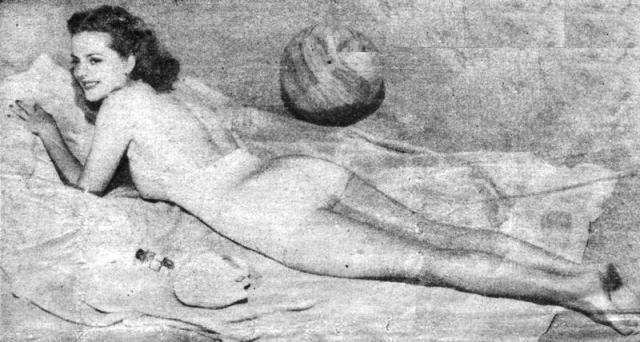 Do these old eyes deceive us, or is lovely Juanita Stark taking her sunbath all by her lonesome?
Send her over to C.B.I. She'd never be lonesome while she was in this Theater.
Do these old eyes deceive us, or is lovely Juanita Stark taking her sunbath all by her lonesome?
Send her over to C.B.I. She'd never be lonesome while she was in this Theater.
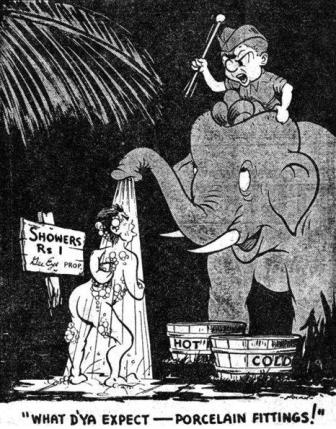
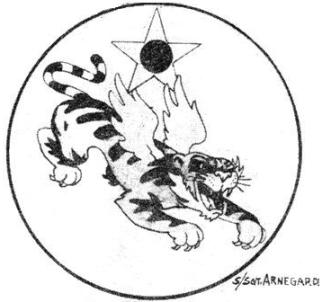 When the War Department recently announced that separate air forces serving overseas are entitled to a distinctive insignia, personnel of the 14th were asked to submit designs. Here is the winnah - submitted by S/Sgt. Howard M. Arnegard of Hillsboro, N.D.
When the War Department recently announced that separate air forces serving overseas are entitled to a distinctive insignia, personnel of the 14th were asked to submit designs. Here is the winnah - submitted by S/Sgt. Howard M. Arnegard of Hillsboro, N.D.
 More than 100 bombing missions over Burma and still at it! That's the proud record of "Old 59" - veteran B-25 of the "Ringer Squadron" East India base. Above you see "Old 59" herself, still sleek and trim after more than 100 visits to our little yellow cousins in Burma. Also shown is the crew that flew the bomber on its 100th mission. Left to right, they are: Lts. Gene E. Lefebvre, navigator; Jack W. Pryor, co-pilot; Robert E. Dales, pilot and S/Sgts. Charles T. Jenkins, engineer-gunner and Joseph H. Miller, radio-gunner. Kneeling, Lt. Raymond G. Curry, bombardier. (Pictures by Sgt. James Ridge.)
More than 100 bombing missions over Burma and still at it! That's the proud record of "Old 59" - veteran B-25 of the "Ringer Squadron" East India base. Above you see "Old 59" herself, still sleek and trim after more than 100 visits to our little yellow cousins in Burma. Also shown is the crew that flew the bomber on its 100th mission. Left to right, they are: Lts. Gene E. Lefebvre, navigator; Jack W. Pryor, co-pilot; Robert E. Dales, pilot and S/Sgts. Charles T. Jenkins, engineer-gunner and Joseph H. Miller, radio-gunner. Kneeling, Lt. Raymond G. Curry, bombardier. (Pictures by Sgt. James Ridge.)
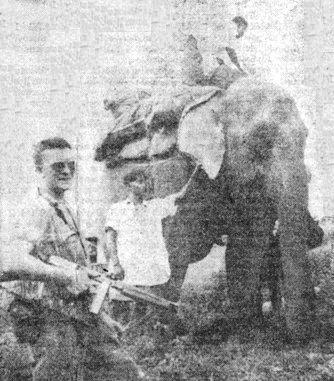 This elephant, encountered by M/Sgt. Byron T. Kain on a recent jungle trek to rescue a wrecked plane, had
never seen a white man before and the local Sabus didn't know how he would react. Kain wasn't taking
chances, as the armament attests, but evidently he's soothing to the eyes of a well-bred elephant, for
nothing happened.
This elephant, encountered by M/Sgt. Byron T. Kain on a recent jungle trek to rescue a wrecked plane, had
never seen a white man before and the local Sabus didn't know how he would react. Kain wasn't taking
chances, as the armament attests, but evidently he's soothing to the eyes of a well-bred elephant, for
nothing happened.


